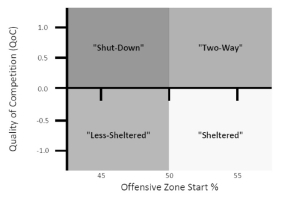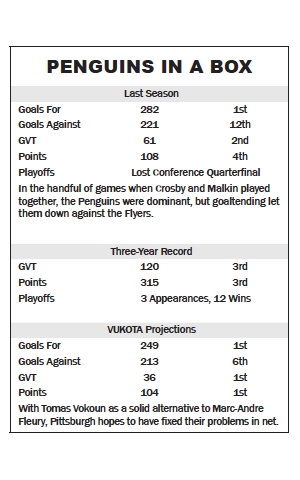Advanced Statistics for Beginners: Player Usage Charts
Posted: 12/01/2013 Filed under: Posts. | Tags: Advanced Hockey Statistics, pittsburgh penguins 4 CommentsHere we are at the final installment of a four part series, you can read the introduction here, part 2 here, and part 3 here. For a much more in-depth explanation of this methodology, please check out PuckProspectus.com, or Faceoff-Factor.com for some high end stats use applied directly to the Pens.
Before fully exploring the charts themselves we must first introduce the three elements that make the chart: Corsi Numbers, Quality of Competition, and Offensive Zone Start %. To quote Timo Seppa and Robert Vollman, the editors at PuckProspectus.com, “Corsi (another poorly-named statistic) is simply a player’s plus/minus, except that it’s measured in attempted shots instead of goals.” In other words, it looks at a player’s effectiveness every shift instead of only the shifts when he happens to be on the ice for a goal. This stat much more accurately represents the overall flow of any specific game and any specific shift. A high positive Corsi Number indicates that a player tends to be on the ice for a lot of offensive, puck control time, whereas a low or negative Corsi Number would indicate a player stuck with the tough task of defending the opposing team’s best players as they control play in your zone.
When Corsi numbers are compared to Quality of Competition stats, we can begin to see how coveted defensive zone specialists are. Again to quote Seppa and Vollman, “‘Quality of Competition’ is the average plus/minus of a player’s opponents over 60 minutes at even strength, except that it is based on [Corsi Scores] instead of goals.” In other words, teams always try to create favorable matchups against their opponents, if the other team has weak defenders on the ice, a good coach will often try to put his best offensive players against them, and that same coach will try to match his best defenders against the opponent’s best scorers. This is why home ice advantage can be so important in the playoffs: home teams get the last change: they can always choose who to send out on the ice (except in icing situations) and thus have the final say in balancing Quality of Competition in their team’s favor.
The final component of the chart is Offensive Zone Start %, which is “the percentage of all non-neutral zone, even strength shifts started in the offensive zone.” In other words, this stat determines whether a player is “given” the opportunity to create offense, or whether they have to fight for the puck in their own zone in order to create their own offense. When you start in your own offensive zone, you tend to have the opportunity to build a greater positive Corsi score, when you start in your own defensive zone, you tend to have a negative Corsi score.
Now that all of that has been explained, a Player Usage Chart can be assembled using all three components. Each individual player is represented by a “Corsi Bubble,” the coloring of the bubble (white or gray) establishes whether the player had a positive Corsi score (white) or negative (gray). The size of the bubble expresses whether that player was outshot by a large margin (big bubble) or by a small margin (small bubble). The horizontal axis represents the Offensive Zone Start % stat: a high horizontal position means you started most of your shifts in the offensive zone, whereas a low number represents a lot of defensive zone starts. The vertical axis represents Quality of Competition, a high vertical score represents good competition, whereas a low or negative score represents easy competition.
The following image is a very easy to understand representation of what the Player Usage Chart represents:
Guys like Jordan Staal, and now Brandon Sutter, would be in the top left quadrant, while if things are going well Sid, Geno, Neal and the other scorers should be on the far right corner, the closer they are to the midpoint the better Bylsma and the other Pens coaches have been at getting them out in favorable matchups. On the negative side of the vertical axis on the left hand side would be 4th liners, guys who aren’t tasked with the hardest checking assignments, but who don’t contribute much offensively. Being on the right side of the graph with a negative vertical score indicates that you are probably young—your coach sends you out only for offensive zone face-offs, and the opposing coach can’t be bothered to defend you with his best guys. Last year Simon Despres and Eric Tangradi earned this distinction for the Pens—this makes sense given that the organization has high hopes for them and wanted to give them favorable playing time.
I hope you’ve enjoyed our little tutorial, and because you’ve been so patient, here is the official chart from the Penguins from last year:
One week til game time. You ready now?
Advanced Statistics for Beginners: Points Per 60 Minutes
Posted: 12/01/2013 Filed under: Posts. | Tags: Advanced Hockey Statistics, pittsburgh penguins 6 CommentsHere we are at the third of a four part series, you can read the introduction here, and part 2 here. For a much more in-depth explanation of this methodology, please check out PuckProspectus.com, or FaceoffFactor.com for some high end stats use applied directly to the Pens.
This statistic is typically broken up into Power Play Points per 60 Minutes (PPP/60) and Even Strength Points per 60 Minutes (ESP/60). In essence to calculate this stat you would take a player’s total production, either on the power play or at even strength, divide it by their total time on the ice at even strength or on the power play, and then multiplied by 60 (which represents minutes), or in other words: Points/Time on Ice x 60 = Points per 60 minutes. This stat is invaluable for eliminating the variable of ice time as an influencing factor on productivity. Basically this stat establishes looks at what each player is able to produce in a given amount of time.
Although there are no hard boundaries on this, a top-six forward should produce at least 2 ESP/60, elite offensive defensemen should be at least near 1 ESP/60. Effective power play players, whether forwards or defense, should expect to produce at least 4 PPP/60. Last year’s fifth rated power play featured four 4 PPP/60 producers (Malkin, Neal, Kunitz, Letang). Ironically, Steve Sullivan, the man most attributed with fixing the Penguins’ PP woes is the only one to have a sub 4 number: 3.79 PPP/60. If you have any doubts about how good Sid can be consider this, in the 21 games he did play last year he had a 4.73 ESP/60, more than one point higher than what Geno produced (3.66 ESP/60).
It is for this reason that I have actually concluded that Tyler Kennedy should be the other winger along with Malkin and Neal, and that he should receive second power play unit time. Although last year may seem like a letdown from TK (11 goals, 22 assists compared to 21 and 24 in 2010-11), it was actually relatively more productive. According to PuckProspectus.com TK managed a very reasonable 2.14 ESP/60, entirely comparable to Chris Kunitz’s 2.22 ESP/60 from last year. Further, in the fateful 2010-11 season (you know the one where Crosby first got concussed, and then Malkin’s knee exploded) when Kennedy played on the top power play unit he produced at a rate of 4.88 PPP/60, the most productivity for anyone on the Pens that year.
More than any of his competition, TK actually has a pretty clear track record of performing when he is given the opportunity, and given that Malkin and Neal ranked first and second respectively in shots on net last year, it seems like TK would have that opportunity with those guys.
So, Go TK? Is that really what I want to say here? I don’t know…
Advanced Statistics for Beginners: Goals Versus Threshold
Posted: 12/01/2013 Filed under: Posts. | Tags: Advanced Hockey Statistics, pittsburgh penguins 8 CommentsHere we are at the second of a four part series, you can read the introduction here. For a much more in-depth explanation of this methodology, please check out PuckProspectus.com, or Faceoff-Factor.com for some high end stats use applied directly to the Pens.
Perhaps the single most invaluable statistic for any sport is the relative value of a starting player over his (or her) replacement. In baseball this statistic is known as VORP, Value Over Replacement Player, and essentially in both hockey and baseball it tabulates how much a given player contributes compared to a fictitious, replacement player: in GVT this player is equivalent to the league average productivity of all players at a certain position (which is different from baseball which assumes comparable defense to the starter, but worse offense). As Tom Awad, the creator of GVT asserts, “GVT… is calculated in goals. This is fundamental: goals, not wins, are the basic building blocks of hockey games.” Basically, it’s only by scoring goals and preventing goals that your team actually earns a win, and as such your ability to contribute to that measure sets you above or below the average.
GVT can be divided into 4 different categories, Offensive GVT, Defensive GVT, Goaltending GVT, and Shootout GVT. Below is the super brief synopsis of each measurement.
“Offensive GVT is extremely straightforward: it measures a player’s contribution to scoring goals. Offensive GVT is based on goals and assists scored above what a replacement-level player would have done with the same ice time.”
Defensive GVT “defines the defense’s job as preventing shots on goal…GVT factors in the number of shots allowed by a player’s team, his plus/minus, and his penalty killing ice time to obtain his defensive GVT.”
Goaltending GVT “defines the goaltender’s job as stopping shots…Goaltending GVT [is] relatively easy to calculate: it is simply the expected number of ogals allowed, given the number of shots face, minus the actual number of goals allowed by the goaltender. As a nod to shot quality effects, the goaltender is only credited for 75% of the extra saves performed, while the defense gets the credit for the remaining 25%.”
“Shootout GVT simply measures whether a player was good at capitalizing on his shootout chances, or preventing them if he is the goalie.” (all quotes from Tom Awad in his “The Essential Guide to the 2012-2013 NHL Season: Hockey Prospectus 2012-13”)
Although this might seem ridiculously complex all you really need to take away is that any player with a positive GVT is a better than “average” player, and anyone with a negative number is not. For example, Geno’s GVT from last year was 27.8 or in other words his measurable statistics are almost 28 times better than the league average. That’s probably why he is the league’s reigning scoring champ and MVP. To show you a little bit more about how GVT evaluates a player’s overall effectiveness we will also examine James Neal’s GVT now. Despite finishing 7th in the league in scoring and 4th in goals Neal only pulled off a 19.0 GVT, good for 23rd in the league (and third on the team behind Pascal Dupuis). You might ask why his number would be so much lower than Geno’s and the answer is simple: the two things that Neal still needs to work on—taking bad, offensive zone penalties, and overall defense—hurt his final score, as such, we can see how much better Geno is than Neal just by looking at GVT stats.

So in other words, this has actually meant his large quantity of penalties last year…Depressing isn’t it?
Overall the Penguins were the number 2 GVT team in the league last year and no guaranteed starter (except for Tanner Glass, who wasn’t in Pittsburgh last year, and who finished a whopping -0.1) earned a net negative GVT, although many of the call-ups did finish with net negative scores. That is actually a really impressive statistic, every Penguin player was essentially above average at his job, no easy feat.
Advanced Statistics for Beginners: Introduction
Posted: 12/01/2013 Filed under: Posts. | Tags: Advanced Hockey Statistics, pittsburgh penguins, PuckProspectus.com 3 CommentsSo if you haven’t picked up on it in Andrew B’s posts or in Mike’s A Modest Proposal series we’re getting nerdy on you all. Whether you like it or not, advanced statistics, sabermetrics, or any of a dozen other names are an increasingly important part of sports writing. And the reason why is as simple as can be: for as cliché as it may sound, numbers don’t lie. We can try to explain what we think we see on the ice or the field or any other playing surface, but it is not easy. Even if we could find every single clip from a game and pinpoint exactly when and what happened, there is still a lot of vagueness in attempting to describe what otherwise fails to meet the proverbial “eyeball test.”
And that’s where advanced statistics come in. These mathematical formulations quantify the unquantifiable; they give meaning to the indescribable, and now they will be part of our blog. Of course there are certain times where we all say reason and science be damned, there are certain times when the eyeball test is not reinforced by the numbers, and there are certain times where a gut-feeling is over-ridden by objective reality. We understand that and we are not setting out to be a numbers only blog. But which two sports could be more interesting to digest through statistical analysis than hockey and baseball?
Baseball is of course the granddaddy of all advanced statistics sports. As a sport with clearly defined roles and positions, clearly defined strategies, and inherently individualistic performance objectives, sabermetrics have been an essential part of the sport for longer than any of us have been alive. No sport uses them to a greater extent, and no sport can be quantified any better than baseball. On perhaps the exact opposite end of the spectrum is hockey—with players moving into and out of specified roles at a whim, with an extremely fluid playing surface, and with a great deal of team-oriented play culminating in nothing except “possession”—the process of quantifying hockey is still a relatively new phenomenon. As such I am dedicating the rest of this post to explaining a number of the important hockey metrics. These metrics will start to influence our posts starting Monday when we begin to layout our official Penguins season preview. The metrics we wish to explore below are Goals Versus Threshold (GVT), Points per 60 Minutes, and Player Usage Charts. Other metrics such as Fenwick, Relative Plus/Minus, and others may appear from time to time but for now GVT, Corsi, P/60 and Player Usage are the most informative, and more importantly the most well developed.
We have come to be completely enamored with the guys at PuckProspectus.com and in fact, all of our stats will be coming from their most recent publication “The Essential Guide to the 2012-2013 NHL Season: Hockey Prospectus 2012-13” an incredibly well-written and well-researched document if I’ve ever seen one. We will split up each topic into separate posts, because although our explanations are very short they still take a few levels of explanation.




